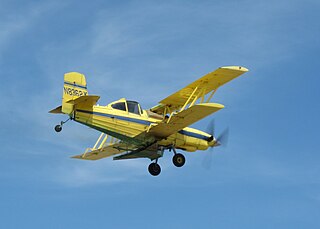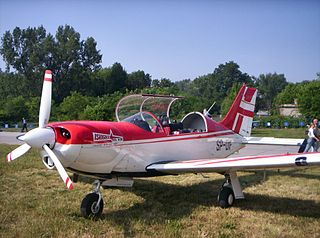
The Piper PA-28 Cherokee is a family of two-seat or four-seat light aircraft built by Piper Aircraft and designed for flight training, air taxi and personal use. The PA-28 family of aircraft comprises all-metal, unpressurized, single piston-engined airplanes with low-mounted wings and tricycle landing gear. They have a single door on the right side, which is entered by stepping on the wing.

The Piper PA-32 Cherokee Six is a series of single-engine, fixed landing gear, light aircraft manufactured in the United States by Piper Aircraft between 1965 and 2007.

The Piper PA-24 Comanche is an American single-engine, low-wing, all-metal monoplane of semimonocoque construction with tricycle retractable landing gear and four or six seats. The Comanche was designed and built by Piper Aircraft and first flew on May 24, 1956. Together with the PA-30 and PA-39 Twin Comanches, it made up the core of Piper's lineup until 1972, when the production lines for both aircraft were destroyed in the 1972 Lock Haven flood.

The Aero Boero AB-180 is an Argentine civil utility aircraft, a substantially improved development of the AB-95. It featured a more powerful engine and incorporated the aerodynamic changes made on the AB-115 and improved on them. The first example flew in 1967 and was in production until 2000.

The PA-25 Pawnee is an agricultural aircraft produced by Piper Aircraft between 1959 and 1981. It remains a widely used aircraft in agricultural spraying and is also used as a tow plane, or tug, for launching gliders or for towing banners. In 1988, the design rights and support responsibility were sold to Latino Americana de Aviación of Argentina.

The Beechcraft Model 76 Duchess is an American twin-engined monoplane built by Beechcraft intended partly as a low cost introduction to twin-engine aircraft.

The Piper PA-48 Enforcer is an American turboprop-powered light close air support aircraft built by Piper in the 1970s. It is a development of the World War II-era North American P-51 Mustang fighter. The Enforcer concept was originally created and flown as the Cavalier Mustang by David Lindsay, owner of Cavalier Aircraft, in response to the United States Air Force PAVE COIN program, but Cavalier did not have the manufacturing abilities to mass-produce the Enforcer, so the program was sold to Piper by Lindsay in 1970.

The Grumman G-164 Ag Cat is a single-engined biplane agricultural aircraft, developed by Grumman in the 1950s.

The Piper PA-31 Navajo is a family of twin-engined utility aircraft designed and built by Piper Aircraft for small cargo and feeder airlines, and as a corporate aircraft. Production ran from 1967 to 1984. It was license-built in a number of Latin American countries.

The PZL-Mielec M-20 Mewa is a licence-built version of the Piper PA-34 Seneca II manufactured in Poland by WSK PZL Mielec in a limited series from the 1980s.

The Embraer EMB 202 Ipanema is a Brazilian agricultural aircraft used for aerial application, particularly crop dusting. It is produced by Indústria Aeronáutica Neiva, a subsidiary of Embraer located in Botucatu, Brazil. The latest version of this aircraft is the first ethanol-powered fixed-wing aircraft, which could give it an economical advantage over the gasoline version. The aircraft is widely employed in Brazil, having market share of about 80%, and the 1,000th delivery was completed on 15 March 2005. Besides aircraft, alcohol-conversion kits for gasoline-powered Ipanemas are also sold.

PZL M26 Iskierka or M26 Airwolf is a Polish trainer and aerobatic aircraft, designed at WSK PZL-Mielec.

The Gavilán 358 is a Colombian light utility transport aircraft of the 1990s. A high-winged monoplane powered by a piston engine, small numbers of Gaviláns were produced in the late 1990s/early 2000s, some serving with the Colombian Air Force.

ENAER T-35 Pillán is a Chilean propeller-driven basic trainer aircraft. The student and the instructor sit in tandem. Production ceased in 1991 after 7 years but restarted briefly in 1998.

The PZL-106 Kruk is a Polish agricultural aircraft designed and built by WSK PZL Warszawa-Okęcie.

The Piper Aerostar is an American twin-engined propeller-driven executive or light transport aircraft, designed by Ted R. Smith. It was originally built by Ted Smith Aircraft Company, but the design was acquired in 1978 by the Piper Aircraft Corporation, which continued production of the aircraft as the PA-60.

The Malmö MFI-10 Vipan was a four-seat light utility monoplane designed and built in Sweden by Malmö Flygindustri. Only three aircraft were built and the type did not enter quantity production.

The Ruschmeyer R 90 is a four-seat light aircraft designed and produced in Germany in the late 1980s and early 1990s.
The Hongdu N-5,, originally known as the Nanchang N-5, is a Chinese agricultural aircraft. First flown in 1989, and entering into production in 1992, the N-5 is a single-engined low-wing monoplane, and is available in versions powered by a piston engine or a turboprop.

The ENAER ECH-02 Ñamcú was a single-engine, two-seat, light aircraft, designed and built by the Chilean manufacturer ENAER. A first prototype flew in 1989, and while the joint venture company Euro-ENAER was set up to build the aircraft in the Netherlands as the Euro-Enaer Eaglet, these plans failed when Euro-ENAER went bankrupt in 2002.






















